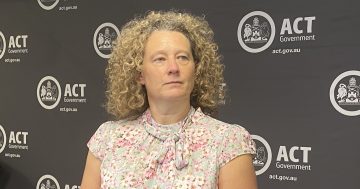
A protestor at the Climate Emergency Rally at Parliament House in February this year. Photo: Michelle Kroll.
Two researchers from the Australian National University (ANU) say that heat-related deaths have been “substantially underreported” and are calling for climate change to be added to death certificates.
Dr Arnagretta Hunter and co-author Dr Simon Quilty of the ANU Medical School say the amount of deaths attributed to excessive natural heat is at least 50 times more than recorded on death certificates.
Their research has been published in The Lancet Planetary Health, with figures showing that during the past 11 years, 340 deaths in Australia were recorded as being due to excessive heat, but statistical analysis found 36,765 deaths could have been attributed to heat.
“Climate change is a killer, but we don’t acknowledge it on death certificates,” co-author Dr Hunter said.
“We can make a diagnosis of a disease like coronavirus, but we are less literate in environmental determinants like hot weather or bushfire smoke.”
The region sweltered through its hottest January since records began in 1939, with the temperature 1.52°C above the long-term average, according to the Bureau of Meteorology.

Dr Arnagretta Huntersaid many Australians died from smoke exposure from the bushfires. Photo: Supplied.
Dr Hunter said Australia’s heat is the most dominant risk posed by climate change.
“We know the summer bushfires were a consequence of extraordinary heat and drought and people who died during the bushfires were not just those fighting fires – many Australians had early deaths due to smoke exposure,” Dr Hunter said.
“There is a second component on a death certificate which allows for pre-existing conditions and other factors.
“If you have an asthma attack and die during heavy smoke exposure from bushfires, the death certificate should include that information.”
The new analysis suggests Australia’s national heat-related mortality rate is around two per cent.
“Climate change is the single greatest health threat that we face globally even after we recover from coronavirus,” Dr Hunter said.
The researchers say death certification needs to be modernised to reflect the impact of large-scale environmental events.
“We are successfully tracking deaths from coronavirus, but we also need healthcare workers and systems to acknowledge the relationship between our health and our environment,” she said.
A similar study earlier this year, published in the Medical Journal of Australia, found that the summer’s hazardous air quality and bushfire smoke may have cost 31 Canberrans their lives.
The study did not analyse pre-existing conditions but measured what public health experts describe as “excess deaths”, or the factor by which observed mortality rates exceed expected mortality rates when major risks like heatwaves, bushfires, pandemics, famine or war are present.
The study estimated that in the ACT, 229 people were admitted to hospital – 82 for cardiovascular problems, and 147 for respiratory problems – while 89 people attended the emergency department because of asthma-related issues.
There were a total of 417 estimated excess deaths because of the bushfire smoke and 4,456 hospitalisations and emergency department visits across NSW, Queensland, Victoria and the ACT.
Environmental health expert from ANU, Professor Sotiris Vardoulakis, said bushfire smoke is a major public health concern.
“These very small particles in bushfire smoke can penetrate deep into the respiratory system inducing inflammation and even translocate into the bloodstream,” Professor Vardoulakis said.
“Mortality rates have been found to increase in Sydney on days with high bushfire smoke pollution.”














